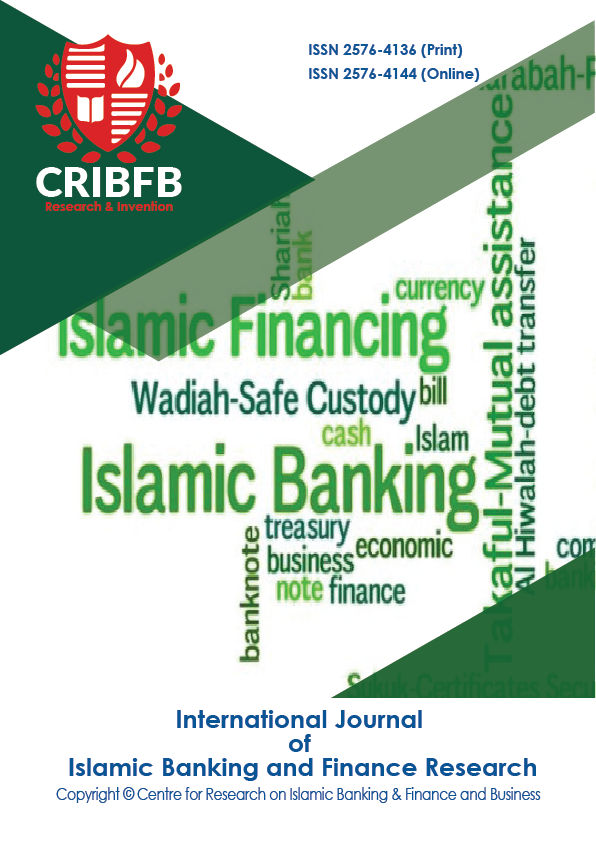MOTIVATION OF FIRMS TO ISSUE SUKUKS
Main Article Content
Abstract
Our paper critically reviews the different factors that motivate a corporation to issue a Sukuk versus a Conventional Bond. Currently, Sukuk papers are growing, yet the studies are limited compared to Conventional Bond research. Our paper analyzes firm performance and characteristics to demonstrate how this affects choosing between the two securities. We examine these in a time series with the 2008 financial crisis intervention to see how this may have affected the issuance choice through logistic regression. Our study examines 628 Conventional Bonds and 227 Sukuk issuers globally across 12 countries from 2005 – 2017. We find in our research that the performance of companies issuing Sukuks resembles Conventional Bond issuers in financial performance. We confirm that larger companies will enter the Sukuk market as an alternative to the Conventional Bond market when there is a higher demand for capital. We also find that firms with higher financial performance may enter the Sukuk market as a premium where it may not be accessible in the Conventional Bond Market.
JEL Classification Codes: G15, G31, G41, F23.
Downloads
Article Details
Section
How to Cite
References
AAOIFI (2018, December 31). Investment in Sukuk Shares and Similar Instruments. Accounting and Auditing Organization for Islamic Financial Institutions. Retrieved from https://aaoifi.com/investment-in-sukuk-shares-and-similar-instrutments/?lang=en
Alswaidan, M. W., Daynes, A., & Pasgas, P. (2017). Understanding and evaluation of risk in Sukuk structures. Journal of Islamic Accounting and Business Research, 8(4), 389-405. https://doi.org/10.1108/JIABR-05-2015-0021
Alexakis, C., Izzeldin, M., Johnes, J., & Pappas, V. (2019). Performance and productivity in Islamic and conventional banks: Evidence from the global financial crisis. Economic Modelling, 79, 1-14. https://doi.org/10.1016/j.econmod.2018.09.030
Godlewski, C. J., Turk-Ariss, R., & Weill, L. (2013). Sukuk vs. conventional bonds: A stock market perspective. Journal of Comparative Economics, 41(3), 745-761. https://doi.org/10.1016/j.jce.2013.02.006
Halim, Z. A., How, J., & Verhoeven, P. (2017). Agency costs and corporate sukuk issuance. Pacific-Basin Finance Journal, 42, 83-95. https://doi.org/10.1016/j.pacfin.2016.05.014
Hayat, R., Den Butter, F., & Kock, U. (2013). Halal certification for financial products: A transaction cost perspective. Journal of business ethics, 117, 601-613. https://doi.org/10.1007/s10551-012-1534-9
IIFM (2019, July). IIFM Sukuk Report 8th Edition. International Islamic Financial Market. Retrieved from https://www.iefpedia.com/english/wp-content/uploads/2019/12/IIFM-Sukuk-Report-2019-8th-Edition.pdf
Jensen, M. C. (1986). Agency costs of free cash flow, corporate finance, and takeovers. The American economic review, 76(2), 323-329. https://dx.doi.org/10.2139/ssrn.99580
Klein, P. O., & Weill, L. (2016). Why do companies issue sukuk?. Review of Financial Economics, 31, 26-33. https://doi.org/10.1016/j.rfe.2016.05.003
Lei, J., Qiu, J., & Wan, C. (2018). Asset tangibility, cash holdings, and financial development. Journal of Corporate Finance, 50, 223-242. https://doi.org/10.1016/j.jcorpfin.2018.03.008
Mohamed, H. H., Masih, M., & Bacha, O. I. (2015). Why do issuers issue Sukuk or conventional bond? Evidence from Malaysian listed firms using partial adjustment models. Pacific-Basin Finance Journal, 34, 233-252. https://doi.org/ 10.1016/j.pacfin.2015.02.004
Nagano, M. (2017). Sukuk issuance and information asymmetry: why do firms issue sukuk?. Pacific-Basin Finance Journal, 42, 142-157. https://doi.org/ 10.1016/j.pacfin.2016.12.005
Nagano, M. (2016). Who issues Sukuk and when?: An analysis of the determinants of Islamic bond issuance. Review of Financial Economics, 31, 45-55. https://doi.org/ 10.1016/j.rfe.2016.05.002
Rosman, R. Wahab, A.N. Zainol, Z. (2014). Effiency of Islamic banks during the financial crisis: An analysis of Middle Eastern and Asian countries. Pacific-Basin Finance Journal, 28, 76-90. https://doi.org/10.1016/j.pacfin.2013.11.001
Smaoui, H., & Ghouma, H. (2020). Sukuk market development and Islamic banks’ capital ratios. Research in International Business and Finance, 51, 101064. https://doi.org/10.1016/j.ribaf.2019.101064
Vizcaino, B. (2014, March 24). Sukuk issuance costs still above conventional bonds in Asia -ADB. Reuters, Financials. Retrieved from https://www.reuters.com/article/islamic-finance-adb/Sukuk-issuance-costs-still-above-conventional-bonds-in-asia-adb-idUSL5N0ML00D20140324




